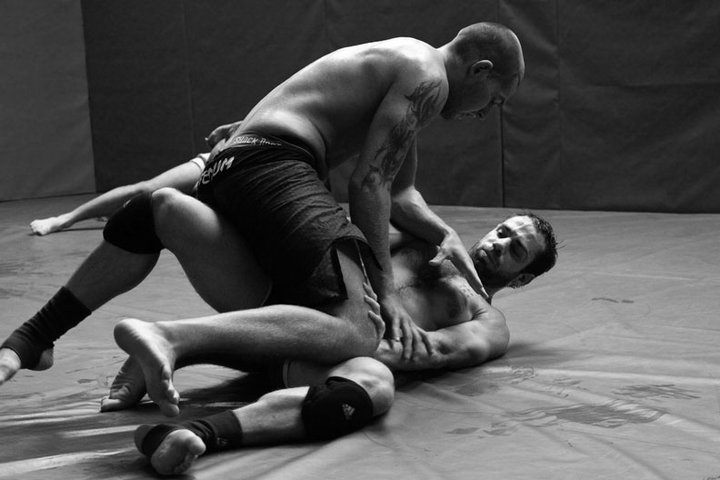Before digging into this article, have you read Part 1 in the article series?
In this part I’ll teach you exactly why you must avoid low-intensity endurance training, and why you should focus on high intensity endurance training. You’ll learn how to target a specific energy system by changing the work-to-rest ratios, the work interval length, the rest period, and the type of exercise.
I’ll show you exactly how to target the aerobic and anaerobic energy systems, and a few other metabolic processes that will improve your performance in the cage; like metabolite buffering, PCr resynthesis, and increasing glycolytic enzymes.
High and low intensity training
First, let’s talk about why you should avoid low-intensity endurance training. As we now know, in order to improve your endurance in the cage, you must target the metabolic and physiological factors that limit your performance; this can be done with endurance training. There are two classifications of endurance training that you should be aware of:
- Low intensity endurance training (low power output, such as marathon running)
- High intensity endurance training (repeated high power outputs, like in MMA)
It is generally agreed that long duration endurance training will impede strength and power gains compared with higher intensity training. This is because low intensity endurance training causes your intermediate muscle fibers to become more oxidative (i.e. slow twitch), which may impair muscular growth along with your capacity to perform the strong and powerful movements that are required in MMA. This happens less with high-intensity interval training.
It is important to note that high-intensity interval training using intervals up to four to five minutes can also improve aerobic fitness (VO2max). This suggests that an interval length of five minutes is probably the upper limit of what you should include in your fight plan. But fighters also require a large anaerobic capacity to perform high intensity combinations. Anaerobic energy systems are best targeted using intervals that are much shorter in duration than aerobic intervals. For this reason, fighters and coaches in MMA should train both aerobic and anaerobic energy systems using a combination of long and short intervals, as discussed below.
How to target the aerobic systems
When your goal is to improve aerobic oxidation (which is the use of oxygen by your muscles) you should also target the systems that deliver oxygen to the muscle. To accomplish these goals, you need to make sure that your muscles are not impaired by metabolite accumulation or depletion of PCr, as these factors will impair your performance. To achieve this, you need to select lower power output exercises (i.e. running), take long rest intervals, and use work-to-rest ratios of 1:0.5 to 1:1.5. When your goal is to improve your ability to perform repeated high intensity efforts over a few minutes, the ability to remove (buffer) metabolites like lactic acid from the muscle and blood appears to be important. To target this, use rest periods that are shorter than work intervals. Typical workouts that target the above outcomes are shown below.
When your goal is to target the capacity of aerobic glycolysis, a typical workout might use work-to-rest ratios of 1:3 to 1:4, and have a work interval of around 2 minutes. But by reducing the amount of rest between work intervals in the 2-minute range, you can target other metabolic processes that are important in MMA. For example, the rate at which your body can resynthesize PCr will probably improve your ability to perform repeated high intensity efforts in the cage. PCr resynthesis appears to be improved using shorter rest intervals (i.e. 2 min on, 1 min off). Similarly, because the accumulation of H+ in the muscles and blood may impair MMA performance, it seems probable that increasing the removal of these metabolites via cellular buffering may also enhance your performance. It appears that 2-minute work intervals separated by short rest periods of 1 to 3 minutes may improve buffering.
How to target the anaerobic systems
When your goal is to target the capacity of anaerobic glycolysis (which also targets the ATP-PCr system) a typical workout might use work-to-rest ratios of 1:5 to 1:6, and use intervals in the 30 s to 90 s range. You’ll also tend to use exercise movements that feature a higher power output (i.e. running whilst pushing a sled, or running with a weighted vest).
When your goal is to target the capacity of the ATP-PCr system, use work intervals that are less than 30 s, with work:rest ratio around 1:3. Further, hydrogen ion buffering appears to improve when 30 s sprints separated by 90 s of rest (8 sets). By increasing the amount of rest between work intervals in the 30 s range, you can also target other metabolic processes that are very important in MMA. For example, when your goal is to increase glycolytic enzymes, which may have a positive effect on anaerobic energy production and exercise performance, it appears that high intensity intervals in the range of 20 s to 30 s, separated by very long rest periods (10 to 15 minute) are good for this.
Shorter work intervals also target the ATP-PCr system; a typical workout might use work-to-rest ratios of 1:20. By reducing the amount of rest between work intervals in the 5 s to 10 s range, you can target other metabolic processes that are very important in MMA. For example, short sprints with little recovery between each has been shown to increase the removal of H+ via cellular buffering, which may enhance your performance in the cage.
Of course, the examples listed above are just the tip of the iceberg. There are countless workouts that can be used to target a particular energy system. If you enroll in our free training programs you’ll be provided with enough specific workouts to fill a 12 months training plan
So let’s leave it here for now. Be sure to watch out for Part 3 of this series, which focuses on over-training in MMA.

Leave a Reply